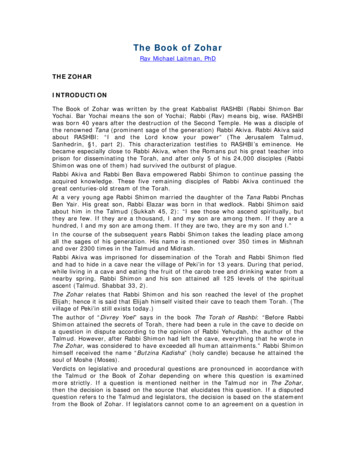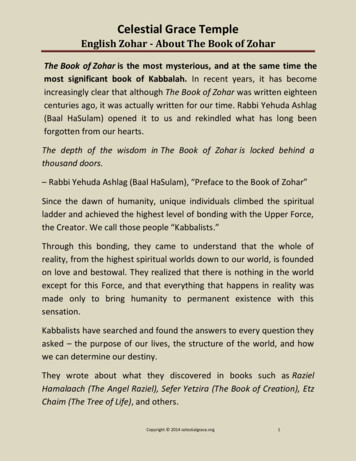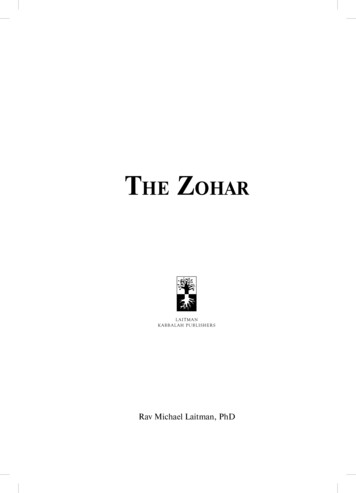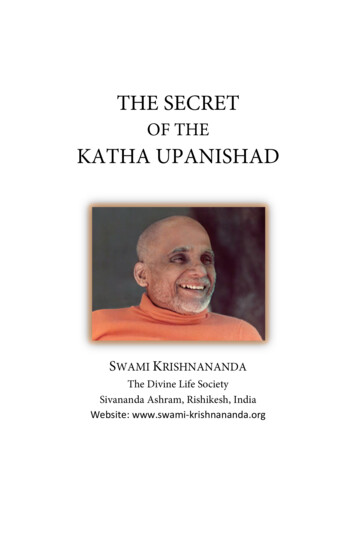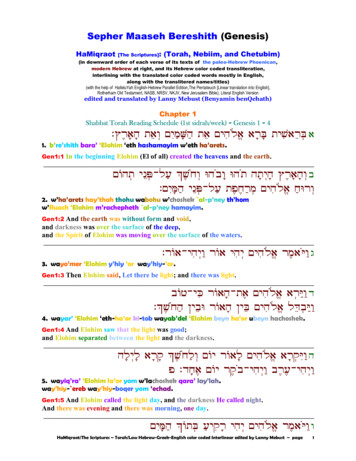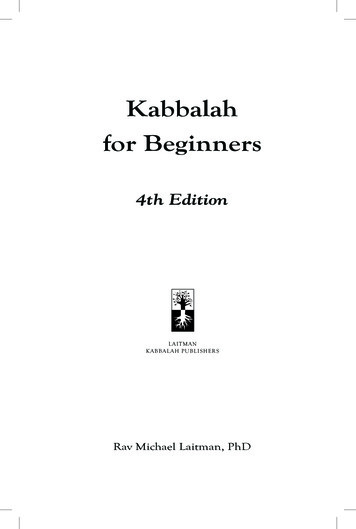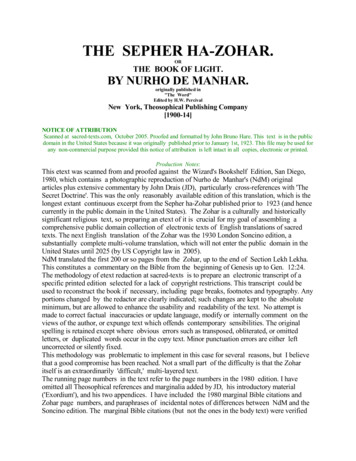
Transcription
THE SEPHER HA-ZOHAR.ORTHE BOOK OF LIGHT.BY NURHO DE MANHAR.originally published in"The Word"Edited by H.W. PercivalNew York, Theosophical Publishing Company[1900-14]NOTICE OF ATTRIBUTIONScanned at sacred-texts.com, October 2005. Proofed and formatted by John Bruno Hare. This text is in the publicdomain in the United States because it was originally published prior to January 1st, 1923. This file may be used forany non-commercial purpose provided this notice of attribution is left intact in all copies, electronic or printed.Production Notes:This etext was scanned from and proofed against the Wizard's Bookshelf Edition, San Diego,1980, which contains a photographic reproduction of Nurho de Manhar's (NdM) originalarticles plus extensive commentary by John Drais (JD), particularly cross-references with 'TheSecret Doctrine'. This was the only reasonably available edition of this translation, which is thelongest extant continuous excerpt from the Sepher ha-Zohar published prior to 1923 (and hencecurrently in the public domain in the United States). The Zohar is a culturally and historicallysignificant religious text, so preparing an etext of it is crucial for my goal of assembling acomprehensive public domain collection of electronic texts of English translations of sacredtexts. The next English translation of the Zohar was the 1930 London Soncino edition, asubstantially complete multi-volume translation, which will not enter the public domain in theUnited States until 2025 (by US Copyright law in 2005).NdM translated the first 200 or so pages from the Zohar, up to the end of Section Lekh Lekha.This constitutes a commentary on the Bible from the beginning of Genesis up to Gen. 12:24.The methodology of etext redaction at sacred-texts is to prepare an electronic transcript of aspecific printed edition selected for a lack of copyright restrictions. This transcript could beused to reconstruct the book if necessary, including page breaks, footnotes and typography. Anyportions changed by the redactor are clearly indicated; such changes are kept to the absoluteminimum, but are allowed to enhance the usability and readability of the text. No attempt ismade to correct factual inaccuracies or update language, modify or internally comment on theviews of the author, or expunge text which offends contemporary sensibilities. The originalspelling is retained except where obvious errors such as transposed, obliterated, or omittedletters, or duplicated words occur in the copy text. Minor punctuation errors are either leftuncorrected or silently fixed.This methodology was problematic to implement in this case for several reasons, but I believethat a good compromise has been reached. Not a small part of the difficulty is that the Zoharitself is an extraordinarily 'difficult,' multi-layered text.The running page numbers in the text refer to the page numbers in the 1980 edition. I haveomitted all Theosophical references and marginalia added by JD, his introductory material('Exordium'), and his two appendices. I have included the 1980 marginal Bible citations andZohar page numbers, and paraphrases of incidental notes of differences between NdM and theSoncino edition. The marginal Bible citations (but not the ones in the body text) were verified
against the electronic King James Version (KJV) of the Bible at .htm), and corrected silently if they varied; in one casethe 1917 Jewish Publication Society (JPS) translation of the Bible is also referenced. In somecases the marginal Bible citations correct the ones in the text, but these are not noted explicitly.All Bible citations added at sacred-texts are in Arabic numerals in chapter:verse format,separated by a colon. In three cases, I paraphrased JD's explanatory marginal material andincluded it in a footnote (with my initials i.e.,--JBH).The marginal Zohar page citations have not been verified against a printed edition other thanJD's. These are in the conventional format of an Arabic number followed by 'a' or 'b', e.g. 32b.NdM's original text had numerous errata and punctuation problems, and the Bible citations are awide variety of formats (and often simply incorrect). Errata were corrected in the conventionalfashion for texts which I prepare for sacred-texts, i.e., any text in green or linked to the erratafile (errata.htm in this directory) was added at sacred-texts by the preparer. Occasionally, minorpunctuation errors or defects were corrected silently. The Bible citations in NdM's text werenot reformatted or corrected in any way, unless there was a correction in JD's marginalia, or anactual errata (such as a malformed Roman numeral or misspelled abbreviation).I added running chapter numbers in Roman numerals solely as placeholders (since many of thesection breaks had no explicit titles); these were inserted at logical breaks in the NdM text(which are also file breaks in this etext). These numbers were not in the original Zohar, NdM orJD's editions, and should not be used for citation purposes.Most problematic are instances where NdM used Theosophical terminology in his translation,e.g., 'Karma,' 'Secret Doctrine,' 'Planes of Existence,' etc. These have not been altered or flaggedin any way, but experienced students of the Kabbalah can identify these easily. In my opinion,however, these terms do not always map neatly into the philosophy and metaphysics of theKabbalah and might be misleading to the novice reader. For this and other reasons, I cannotrecommended this as an introductory text about the Kabbalah!It is my belief that this level of redaction does not embody enough 'creativity' (in the US legaldefinition of the word) to void the public domain status of the text or justify a new copyrightclaim. I take sole responsibility for these alterations and emendations. Moreover, I explicitlydonate my redactions to the public domain.--JBH.THE SEPHER HA-ZOHAR.ORTHE BOOK OF LIGHT.BY NURHO DE MANHAR.AS a preliminary to the translation of the great Kabbalistic work, "The Sepher Zohar, or Bookof Light," we purpose to sketch in brief outline the history of its origin, the nature and purposeof its doctrines and teachings, as also the great influence of its philosophy which is reflected inthe writings of Albert the Great, Reuchlin, Raymond Lully, Boehmen, More the Platonist,Spinoza, Balzac, and many others whose names are famous in the annals of literature andlearning. To the readers of the late Madame Blavatsky's works, "Isis Unveiled" and "The SecretDoctrine," this will doubtless prove acceptable and enable them to understand and comprehendthose parts in which she has incorporated the philosophy respecting the Sephiroth and shown itsclose similarity in many of its aspects with Eastern teachings. There is scarcely a page in whichsome reference to it is not found, with Hebrew words, the explanation of which would have
enhanced the value of the above works and added to the enjoyment and edification oftheosophical students in general. To supply this desideratum it will be necessary to give detailsrespecting Kabbalah of which the Zohar is justly considered to be the prolific fountain fromwhich has flowed that stream of occult philosophy that has entered so largely as an element inthe teachings of mystics of ancient and modern times.The ancient Jews were not different from other nations in having occult schools and institutionsin which secret doctrines were inculcated and imparted to neophytes, or the sons of theprophets, as they are termed in the Bible. These teachings were twofold in their nature andcharacter, and denominated Beresith, or the science of the natural world; also Mercaba, whichhad relation to heavenly or spiritual science, and whichp. 2was esteemed and regarded as most sacred and never to be revealed except to initiates, and thenonly orally, as amongst the ancient Druids. That which was received was termed "Kabbalah," aHebrew word, signifying reception, or, rather, what is received and handed on to others in shortaphorisms and mnemonical words, the meaning of which could only be deciphered andcomprehended by those who had successfully passed through a long course of esoteric studies.For instance, A D M, or Adam, taught that the soul of Adam the first was incarnated in Davidthe King and will eventually appear in the form of the Messiah. It is said that Kabbalah firstoriginated after the expulsion of Adam from the Garden of Eden, and was communicated to himby the angel Raziel in order that he might be better able, through attending to its teachings, toregain his lost estate. The common tradition and most generally accepted is that Moses himselfwas the real author of Kabbalah, having received it during his residence of forty days andnights on Mount Sinai. After his descent therefrom he imparted it to Aaron, who in turn handedit on to his sons, through whom it was given to the seventy elders of the children of Israel andcoadjutors of Moses in juridical government and polity. Through the judges, especially theprophet Samuel, it was delivered to David and Solomon, the latter becoming renownedthroughout the East for his extensive and profound knowledge of Kabbalah, by which he wasable to perform marvelous things and acquire control over all beings, demons, spirits of the air,fire and water, and make them his obedient and subservient ministers.During the reigns of the various kings of Israel and Judah we gather that this Kabbalah waswidely taught and studied in the schools or colleges of the prophets, presided over byhierophants, of whom Elijah and Elisha were remarkable examples, and distinguished not onlyby their loftiness of character, but also for their knowledge and manipulation of nature's occultforces and powers, by which they stand out boldly and prominently in Jewish history. Theseoccult societies were generally distinguished by the wearing of some special badge or emblemindicative of the peculiar occultism of which they were the professed followers and adherents,such as a raven or hawk, eagle or dove, a lion, a wolf, an ox or a Iamb. Their members,whenever sent out on any benevolent expedition or political mission, always went in couples,similar to the rule of custom in voguep. 3at the present time with monks and nuns in the Roman Catholic community. From this fact weobtain a satisfactory and rational explanation of the extraordinary and miraculous feeding ofElijah by two ravens, who brought him in his place of retirement and concealment bread andmeat for his daily sustenance. Instead of two birds noted for their thievish propensities, we seehow two members of an occult school, who were perfectly acquainted with the whereabouts ofElijah, and so ministered to the bodily wants and necessities of their great hierophant. It is alsorelated of Alexander the Great, on his entering into one of the chief cities of Egypt, that he was
welcomed by twelve doves at the head of a large procession of the citizens, and who greeted hispresence with some remarkable signs of congratulation, the strangeness of which vanishes anddisappears when we recognize in these doves members of some occult institution held inveneration by the general populace, and thus qualified to be the exponents of their good wishesand feelings toward the conquering Alexander. The Babylonian captivity brought the Jews intoimmediate contact with Chaldean and Persian philosophy, which introduced a great change intheir speculative ideas of the creation and divine government of the world, Chaldean magic andoccult science became objects of deep interest and study, and ultimately resulted in theformation of new societies and sodalities, in which secret rites and ceremonies were performedand celebrated. All knowledge of their teachings was jealously guarded, and their memberswere bound by the most solemn oaths not to divulge or reveal them to the profane or commonpeople. These esoteric schools abounded throughout the East, especially in parts of Arabia andadjacent countries.And now we enter into the historic domain and gather from the pages of Philo Judaeus, a famedJewish mystic and philosopher, who in his treatise on the advantages accruing from acontemplative life makes mention and reference to the Essenes and gives a somewhat fullaccount of their methods and objects of study. They lived an ascetic life, and at stated intervalsindulged in meditation after reading portions of sacred hooks or writings entrusted to them. Atother times they assembled in solemn conclave for interchange of thoughts and ideas which hadcome to them in the seclusion and silence of their cells. "They spoke slowly and withdeliberation," says Philo, "regarding eloquence not so much as clearness in expression ofp. 4ideas. They frequently repeated themselves in order that their sayings might become engravedon the minds of their auditors. In the interpretation of Scripture they indulged greatly in the useof allegories, as the law appeared to them like a living being. The physical body was the lettersand words; the soul was the invisible spirit hidden within them, a spirit by which the student,guided and led by reason, begins searching after those things which are of importance to him;discovering most wondrous and beautiful thoughts under the form that envelops them; rejectingmere outward symbols in order to lead the mind to the light and for the use and advantage ofthose who, with a little aid, are able to perceive truths and things invisible by means of andthrough things visible." They fully recognized that the spiritual world was no remote region inthe universe, but was surrounding them and not very far away from them. For them thereexisted no broad deep gulf, no solid wall or partition between the natural and spiritual worlds,no insuperable and impenetrable barrier between them and the spirits of great and good menmade perfect and who had once been teachers to nations. If differences there was betweenthem, it was one of state and condition, and this they endeavored to mitigate and obviate bypurity of life and thought, esteeming no self-denial too great, no sacrifice too transcendant orcomparable to the enjoyment of spirit intercourse and instruction, resulting in the subjugation oftheir lower nature, and so clarifying their minds that they became luminous mirrors in whichwere reflected the secrets of the universe. This was their philosophy as expressed by an oldArabian sago. "When my soul," said he, "shall become in harmony with the divine life, thenwill it be a reflection of nature's great and secret. truths."Such is the general description of these occult schools or lodges widely prevalent in the East,and which continued to exist to the time of Rabbi Simeon ben Jochai, the great Kabbalist andreputed author of "The Zohar, or The Book of Light," whose name is held in reverence andesteem by all true students of occult philosophy. His biography, though short, is notuninteresting in its character and details. He lived and taught in the reign of Hadrian, the Roman
Emperor, when the Jewish nation was subject to much hardship and persecution and theirRabbis or recognized teachers labored under grievous disabilities, being prohibited from givinginstructions to their students, a restriction which Rabbi Simeon had the singularp. 5boldness and courage to ignore and disregard, and thus incurred the anger and displeasure ofthe Roman rulers. He had to flee for his life and conceal himself in an unknown and solitaryabode. He had been holding a discussion in one of the synagogues with Jehuda ben Illai andJose ben Halefta, two famous Rabbis, on the comparative character of Jewish and Romanmanners. Jehuda commenced his discourse with an eloquent eulogium on the Romans as thegreatest promoters of the material convenience and civilization of the people they governed,instancing their public works, architecture, and the patronage they gave to the useful arts.When Rabbi Jose's turn came to speak he exhibited the cautiousness which had given him thesurname of "The Prudent," and observed an impressive silence. The discretion of his colleagueswas, however, lost upon Simeon, whose animosity to the Romans for the harshness and crueltyexhibited toward his brethren vented itself in a fiery invective against the oppressors, which,becoming the topic of public conversation, aroused and excited the displeasure of the civilauthorities. He, along with the above Rabbis, was summoned to appear before the magistrates.The silence of Rabbi Jose was deemed a sufficient ground for banishment to Sepphoris; RabbiJehuda was allowed to exercise the office of a preacher in the synagogue; but Rabbi Simeonwas condemned to death, a sentence which he evaded and escaped by immediate and timelyflight, accompanied by his son Eliezar. For several years he remained in seclusion and lived asa hermit in a cavern, engaged in the development of Kabbalistic science as embodied in theBook of Zohar. After the death of the Emperor Antoninus he left his place of concealment andreappeared as the founder of a school in Tekoa, a town in Palestine. About three hundred of hissayings are recorded in the Talmud. The whole of his life was absorbed and spent in the studyof Kabbalah, in which science he was and still is regarded as one of its most eminent masters.He lived in a world of his own, in a region beyond the bounds of ordinary nature. Students andlearned Rabbis from all parts flocked to him and enrolled themselves as members of his school,in which subjects of the highest philosophy were discussed. Instructions by great teachers, suchas Moses, who in the Zohar is styled The Faithful Shepherd, and the great prophet Elijah, whoin luminous and resplendent forms appeared in their midst, were imparted on matters andsubjects of the most abstruse and occult character, and which were recordedp. 6in secret writing by students deputed and chosen for that object. There is an affecting accountof his death given by one of his students in the "Idra Seta, or "Lesser Assembly," one of theappendices to the Zohar. As a teacher he had lived and as a teacher he died, surrounded byscholars who loved him dearly. "Mercy," he was saying, "hath ascended unto the Holy ofHolies, for there Adonai hath commanded his blessing forevermore, even life everlasting."There was a sudden pause. His head fell slowly on his breast. Intently gazing upon him, theylistened in deep silence for further words, but no words came from those lips that had been soeloquent in speech. They were his last words, and not inappropriate as a finale to a life like his.Suddenly a strange supernatural light surrounded the house. "At that moment," says Rabbi theScribe, "I heard a voice, which said: 'Before thee are countless days of blessedness,' and thenanother, saying: 'He asked life of thee and thou gayest him the years of eternity.' Throughout allthat day the flame continued around the house, and no man entered or went forth. I lay weepingand sobbing on the ground. At length the fire departed, and I perceived that the soul of him whowas the Light of Israel had departed also. His corpse was reclining on the right side, and a
smile was on his face. Eliezar, his son, took his hands and kissed them. We could find noutterance for our grief till tears began to flow. Three times his son fell down in speechlesssorrow. At length the power of utterance came to him, and he cried, 'Father! Father!' As thefuneral procession moved toward the grave a light revealed itself in the air, and a voice washeard exclaiming: 'Come! Gather yourselves together to the marriage feast of Simeon.'"Ere entering upon the analysis of the Zohar and its con-tents, we would premise that theKabbalists teach that the Divine Being has expressly committed his mysteries to certain chosenindividuals, who in their turn handed down to others who proved themselves worthy recipientsof them. These mysteries relating to man's spiritual existence and guidance are concealed inparts of the Holy Scriptures, the interpretation of which is the province of Kabbalah. Tounderstand these mysteries the student will find it necessary to acquaint himself with themetaphysical principles as laid down in the earliest writings and documents of this science, as inlater times professors of Kabbalah have incorporated with it many of their own ideas andphilosophic doctrines culled from Greek and Arabian sources.p. 7Kabbalah as a constituted science or system of Theosophy is divided into two separate sections,The Theological and The practical; this dealing with the visible creation and termed Bernhik;that dealing with the spiritual world and the attributes and perfection of the Divine Being isdenominated the Mercaba, or the chariot throne, with its attendant angels, as seen and describedin the opening chapters of the Book of Ezekiel the Prophet.The doctrines of Creation are succinctly outlined in the "Sepher Yitsira, or Book of Creation,"the imputed author of which is said to be no less a personage than Abraham the Patriarchhimself. As this work, with a translation of its contents, will form a subject of futureconsideration, we shall confine our remarks to the no less important Kabbalistic work, TheZohar.In order that our readers may obtain a clearer idea of the philosophy of this strange andremarkably interesting book, it will perhaps not be out of place to lay down or touch upon a fewof the fundamental axioms which more or less form the basis of systems of philosophy, ancientor modern, Eastern or Western, and especially in Kabbalah; such as "From out of nothing,nothing can proceed; therefore no substance that now exists has been produced from nothing,and whatever exists is in one sense untreated. All existing substances are emanations from oneeternal substance." In the act of what is commonly termed creation the eternal Being drew fromhimself; consequently there is no such thing as matter in our sense of the word. Whatever wecall matter is only another form or species under which the spirit comes into manifestation.Therefore the universe is a realization of the Infinite, an immanent effect of his ever-activepower and presence. Though all existence flows front the divine, yet is the world different fromthe Godhead, as the effect is different from the cause. Nevertheless, as not separate, but abidingimmanently in him, creation is evermore the manifestation of himself. The world is the mantlewith which he clothes himself, or, rather, it is a revelation of the Godhead, not in his hiddenessence, but in his visible glory. In giving existence to the universe the first act of the almightywas the production of a power and principle intimately and specially related to himself, to whichare given the names of his holy spirit, his personal world, his first-begotten son and which theKabbalists in general personify and term Adam Kadmon, or the archetypal Man, and who inturn caused to proceed from emanations from himselfp. 8all the lower forms of actual existence in their several descending series and gradations.According to Kabbalists, God is the author of the letters. Spirit is a revelation of thought and
the form in which intellect or mind pronounces itself most distinctly. Letters are the organicelements of speech, and therefore he who taught man language or who made him, as one of theTargums expresses it, "ruach mamelella," a speaking spirit, must have been the author of theletters of the primeval language. The first ten numbers and the twenty-two letters of thealphabet, considered analogically as types of divine operation, are denominated the thirty-twopaths of wisdom of which the almighty created the universe. "The works of God," says theauthor of "Cosri," another famous Kabbalistic work, "are the writing of Him whose writing ishis Word, and whose word is his thought, so that the words, work and thought of God are one,though they seem to man to be three." As in the universe harmony reigns in manifoldness, sothe letters and numbers constitute a system which has its centre and hierarchy. The unitpredominates over the three. The three rules over the seven; the seven over the twelve. Thecentre of the universe is the celestial dragon. The circuit of the zodiac is the basis of the year.The heart is the centre in man. The first is elevated in the world like a king upon his throne. Inthe seven organs of the body there is a kind of opposition which sets the one against the otheras in battle array. Three promote love, three engender hatred. Three bestow life, three lead todissolution, and one cannot be apprehended by the mind without the other. Over the whole ofthis triple system, over man, the world and time, over numbers, letters and sephiroth, the onlytrue king, the one God rules forever and ever. Such are the chief fundamental ideas whichpermeate the whole texture of the Zohar, which, as we have observed, forms the standard andcode of Kabbalistic philosophy. The body of the books takes the form of a commentaryextending over the five books of Moses, viz.: the Book of Genesis, Exodus, Leviticus,Numbers, and Deuteronomy, and is of a highly mystical and allegorical character, and whichwas the most general and favored method of teaching and imparting instruction in Easterncountries. In addition to these, there are eighteen supplementary portions, viz.:1. Siphra Dzeniutha, The Book of Mysteries.2. Idra Rabba, The Great Assembly, referring to the schoolp. 9or college of Rabbi Simeon's students in their conferences for Kabbalistic discussion.3. Idra Seta, The Lesser Assembly, of the few disciples that that remained for the same purposetoward the end of their master's life or after his decease.4. Sabba, The Aged Man.5. Midrash Ruth, a mystical exposition of The Book of Ruth.6. Seper Ha Bahia, The Book of Clear Light.7. Tosephtha, An Addition.8. Raia Mehima, The Faithful Shepherd (Moses).9. Hechaloth, The Palaces.10. Sithrey Torah, The Secrets of the Law.11. Midrash Ha-Neelam, The Concealed Treatise.12. Rose de Rasin, The Mystery of Mysteries.13. Midrash Chasith, On the Canticles.14 Maamar Ta chasi, a discourse, so-called from its first words, "Come and See."15. Ianuka, "The Youth."16. Pekuda, Illustrations of the Law.17. Chibbura Kadma, The Early Work.18. Mathuitin, Doctrines.The commentary is sometimes called Zohar gadol, the Greater Light; the supplements, ZoharKaton, or the Lesser Light. Though the Zohar is said to be a commentary on the Pentateuch, it
must be understood that the interpretation is Kabbalistic, and that the literal sense of the wordsis only a covering or garment of the true meaning. With the Kabbalists there are two ways ofregarding and speaking of the Divine Being. When they speak simply and directly of his natureand attributes their style is severely metaphysical and abstruse, but at other times they indulgein the use of metaphor and allegory to a most extraordinary, if not extravagant, degree, at thesame time declaiming against the possibility of any attempt to describe the incomprehensible(because infinite) Being. This is especially the case with the Siphra Dzeniutha, or Book ofMysteries, of which the following extract is a fair sample of its style:"He is the ancient of ancients, the mystery of mysteries, the concealed of the concealed. Hehath a form peculiar to himself, but he hath chosen to appear to us the ancient of ancients. Yet inthe form whereby we know him he remainethp. 10still unknown. His vesture is white and his aspect that of an unveiled face. He sitteth on a throneof splendors, and the white light streameth over a hundred thousand worlds. This white lightwill be the inheritance of the righteous in the world to come. Before all time En Soph, theboundless One, the unoriginated and infinite Being, existed without likeness, incomprehensibleand unknowable. In the production of finite existence the first act was the evolution of theMemra, or the Word, which was the first point in the descending series of beings, and fromwhom in nine other degrees of manifestation emanated those forms which at once compose theuniverse and express the attributes and presence of its eternal ruler. To these nine forms isgiven the common name of Sephiroth, signifying Splendors. The whole or some of theseSephiroth constitute the universe, the manifestation of God, their names being:1. Kether, Crown.2. Chocma, Wisdom.3. Binah, Understanding.4. Chesed, Mercy.5. Din, Justice.6. Tiphereth, Beauty.7. Netzach, Triumph.8. Hod, Glory.9. Yesod, Foundation.10. Malkuth, Kingdom or Dominion.The primordial essence is before all things. In his abstract and eternal nature and condition he isincomprehensible, and as an object of the understanding, according to the Zohar, he is nothing,the mystery of mysteries; but he took form as he called forth them all. The ancient of ancientsis now seen in his own light; that light is his holy name, the totality of the Sephiroth. The orderof their emanation is as follows: From Kether, the Crown, the primal emanation of En Soph,proceed two other Sephiroth--Chocma (wisdom), active and masculine; the other Binah(understanding), passive and feminine, the combination of which results in thought, of whichthe universe is the effect. The crowned Memro, or Kether, or primordial Logos, is the thinkingpower in creation, Chocma the act of thinking, and Binah the subject of the thinking. SaysCordovero, author of a famous Kabbalistic work, Pardis Rimmonim, or the Garden ofPomegranates: "The forms of all earthly beings are in these three Sephiroth, as they themselvesare in him who is theirp. 11
fountain." The seven other Sephiroth develop themselves also into triads, in which twoantithetical members are united by a third. Thus Chesed (mercy) is the antithesis of Din(justice), and both are united in Tiphereth (beauty). These terms, however, are not used as inour common theology and ethics in the moral or spiritual sense, but have rather a cosmologicalor dynamic meaning, Chesed signify
The Zohar is a culturally and historically significant religious text, so preparing an etext of it is crucial for my goal of assembling a comprehensive public domain collection of electronic texts of English translations of sacred texts. The next English transl
